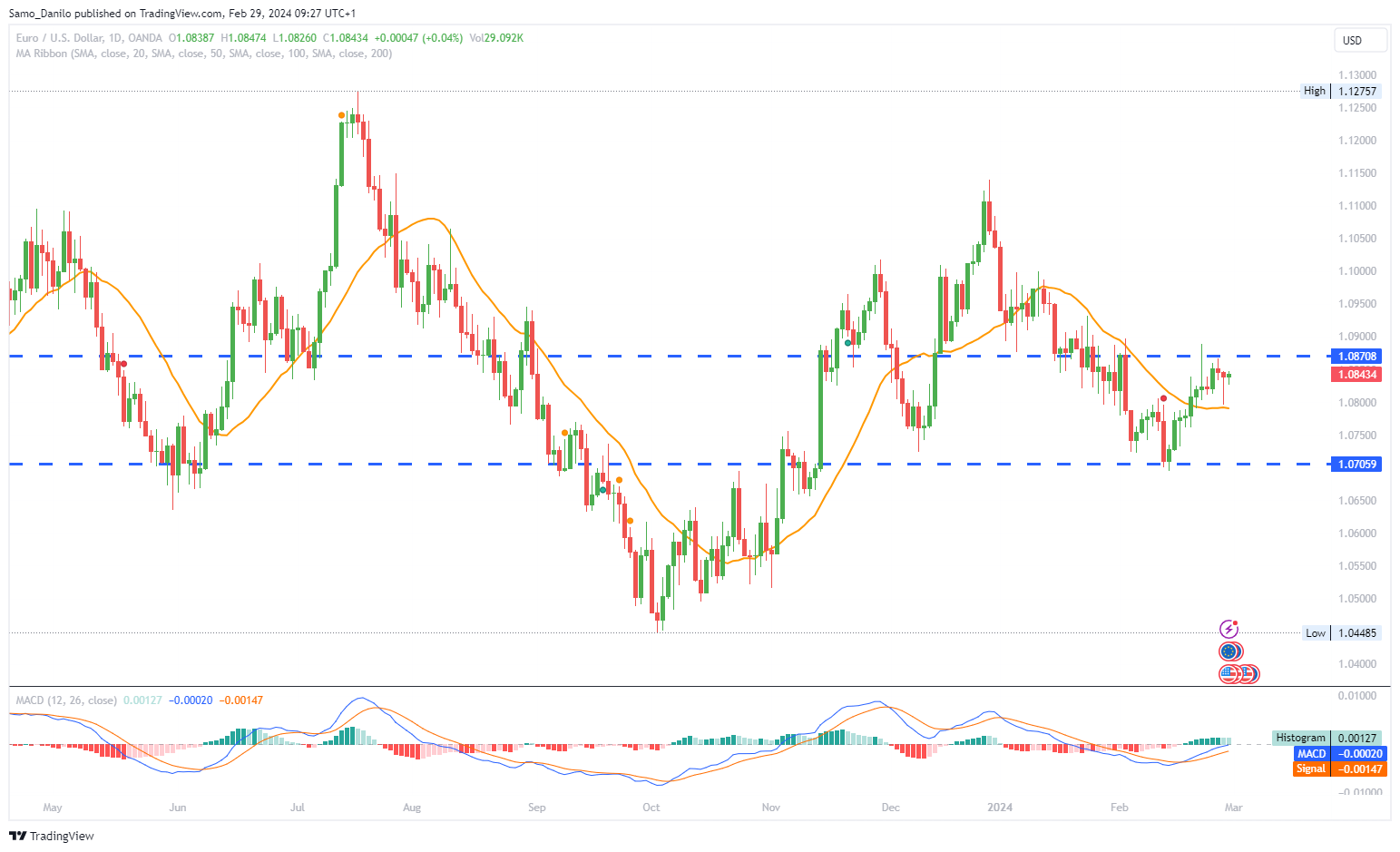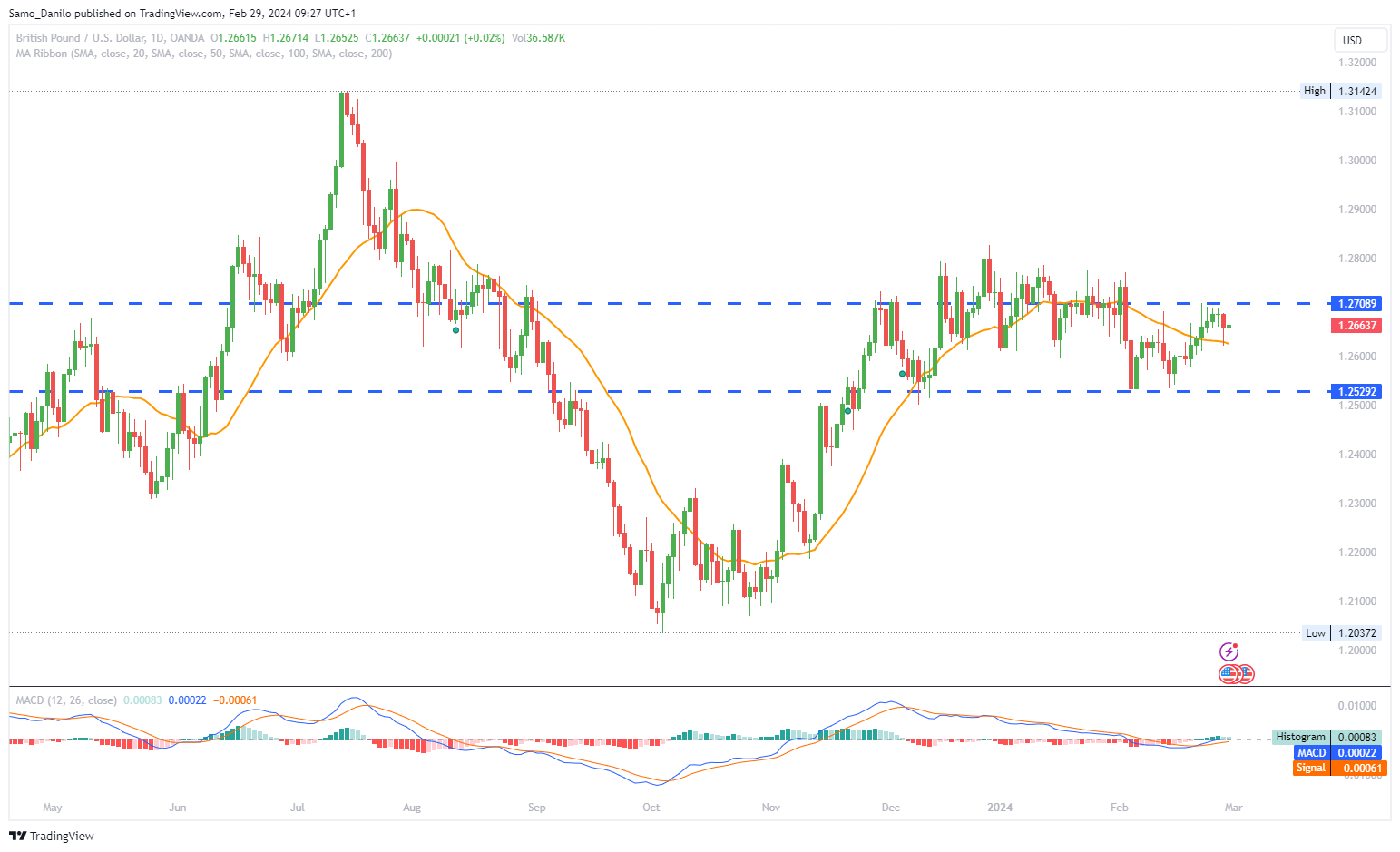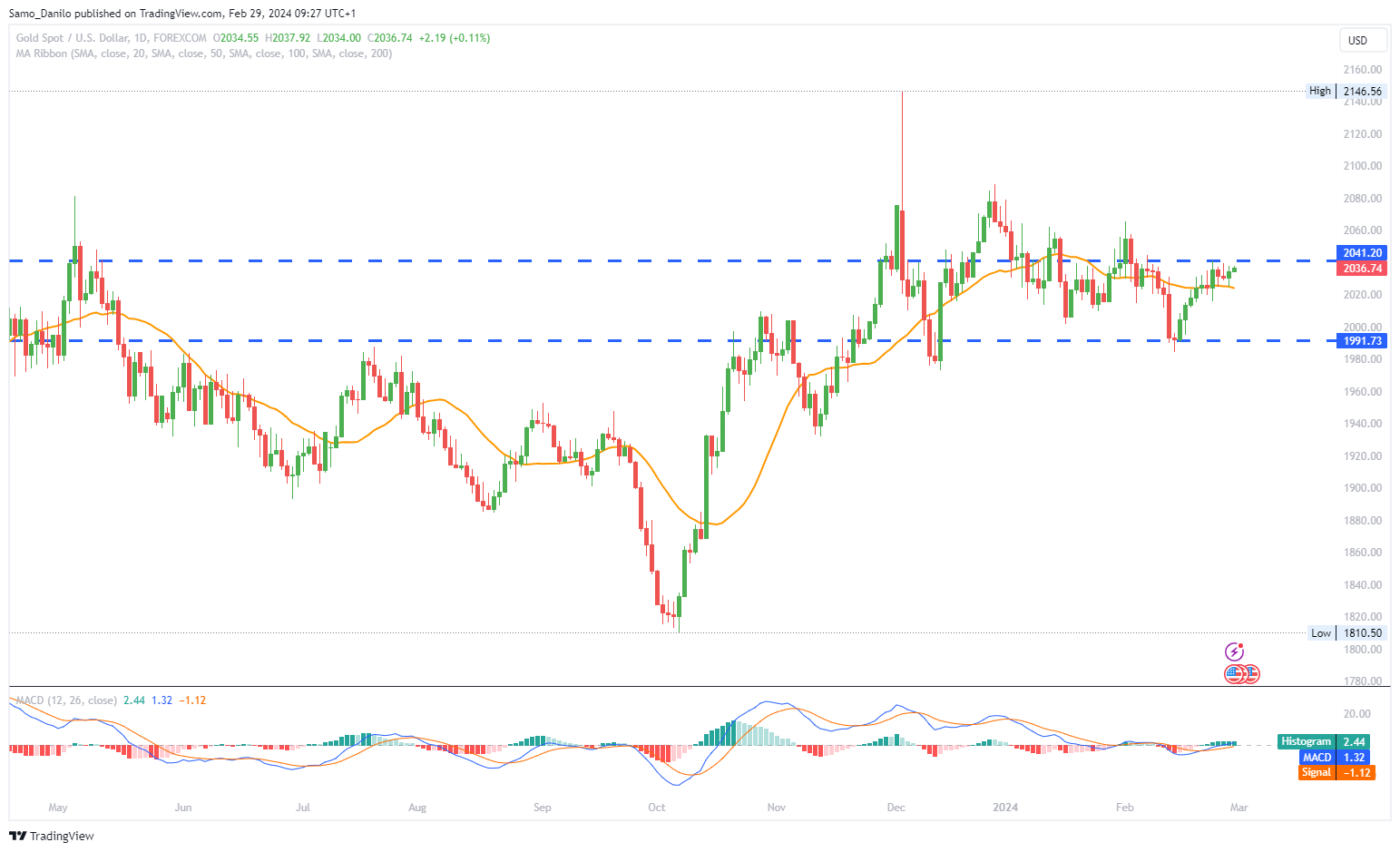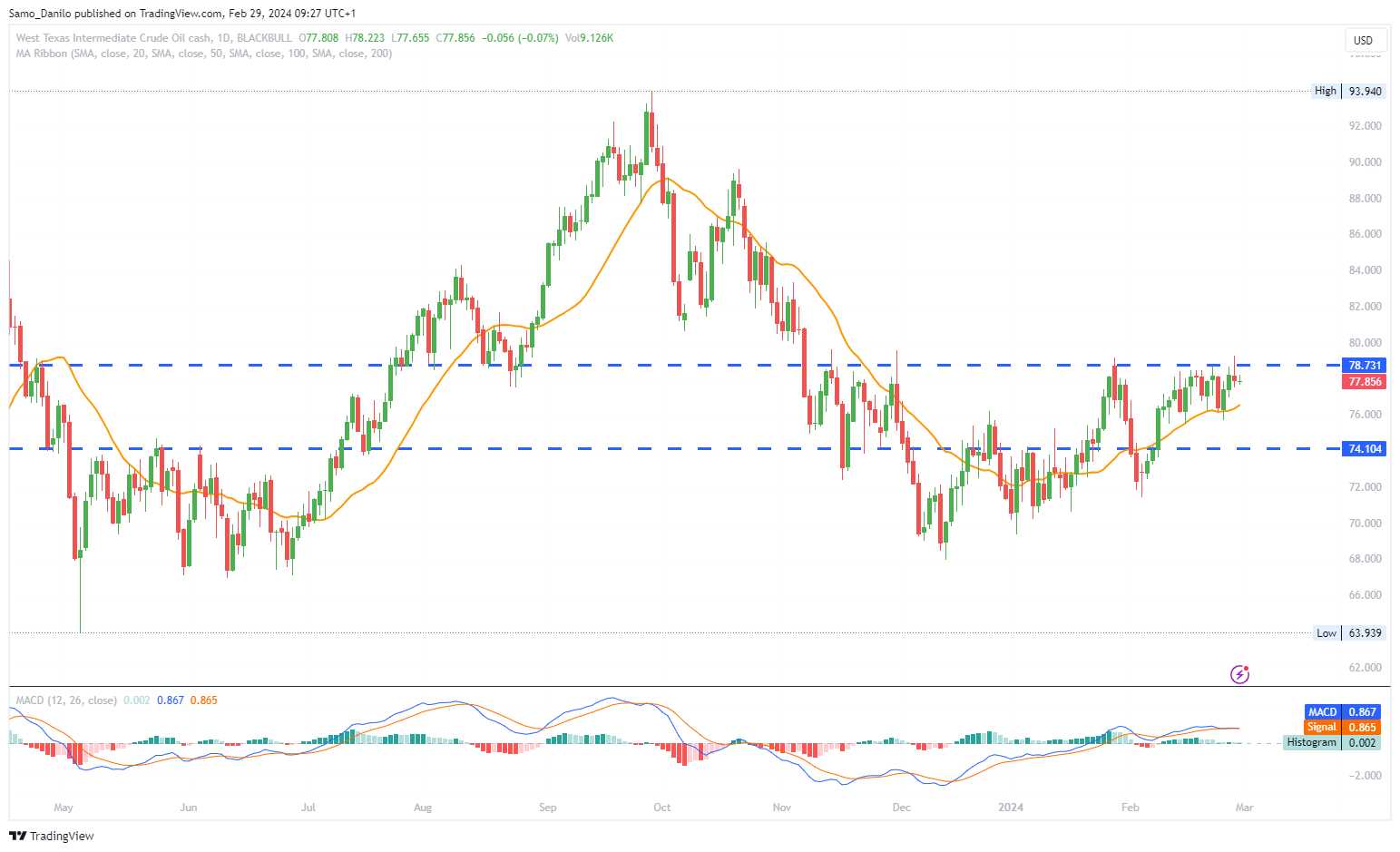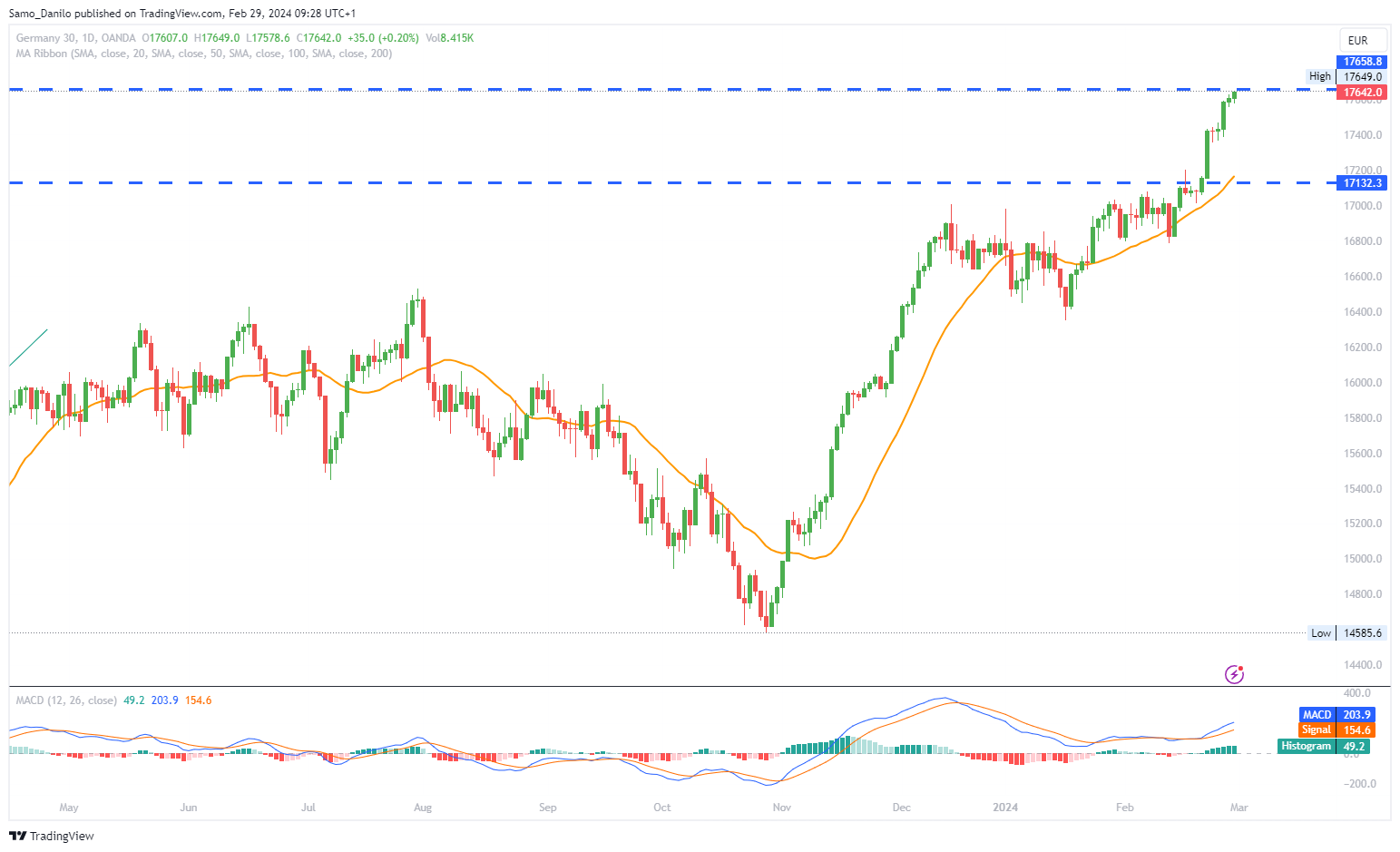EURUSD
- Sideways Trading Above 1.0800: EUR/USD is maintaining a sideways trajectory above 1.0800 in the European morning on Thursday. This stability is attributed to the prevailing weakness in the US Dollar, providing support for the Euro.
- ECB Policymakers' Agreement: According to Reuters' sources, the European Central Bank (ECB) policymakers, in their meeting last week in Frankfurt, reached a consensus to adhere to a "floor" system. In this system, the central bank effectively establishes the lowest rate at which banks would lend to each other.
- Europe's Economic Sentiment Indicator: The Economic Sentiment Indicator for Europe declined to 95.4 in February, falling short of the expected 96.7. January's reading underwent a slight revision from 96.2 to 96.1.
- US Q4 GDP Data: The US Gross Domestic Product (GDP) for the fourth quarter quarter-on-quarter (QOQ) printed at 1.7%, surpassing the forecasted figure of 1.5%. This positive economic data contrasts with Europe's sentiment indicators.
- Upcoming Data: Thursday brings a substantial amount of data for investors. The focus will be on the Consumer Price Index (CPI) numbers, offering insights into inflation trends. Additionally, the market will closely follow the US Personal Consumption Expenditure Price Index (PCE) for further indications of inflationary pressures.
Closing statement: EUR/USD is navigating a sideways path, supported by a weakened US Dollar. ECB policymakers' commitment to a "floor" system is notable. Europe's Economic Sentiment Indicator showed a decline, contrasting with positive US Q4 GDP data. With upcoming inflation-related data, the pair remains subject to market reactions based on economic indicators from both the Eurozone and the United States.
GBPUSD
- Recovery from Multi-Day Lows: The GBP/USD pair has rebounded from multi-day lows near 1.2620, showing signs of recovery and reaching 1.2660 during the early Asian session on Thursday.
- US Q4 GDP Data: On Wednesday, the US Gross Domestic Product (GDP) for the fourth quarter grew at a 3.2% annualized rate, a slight decrease from the previous reading of 3.3%, according to the US Bureau of Economic Analysis (BEA).
- Comments from New York Fed President: New York Federal Reserve (Fed) President John Williams mentioned on Wednesday that there's still some distance to cover in achieving the Fed's 2% inflation target. However, he indicated that the door is opening to potential interest rate cuts this year, depending on incoming data.
- Impact of Inflation Data: Recent inflation data has influenced financial markets, causing a shift in expectations for the timing of the first rate cut, providing support for the US Dollar.
- Upcoming US PCE Price Index: Investors are eagerly awaiting the release of the US January Personal Consumption Expenditures Price Index (PCE) on Thursday, anticipating its potential impact on market dynamics.
| SMA (20) | Slightly Falling |
|
| RSI (14) | Slightly Rising |
|
| MACD (12, 26, 9) | Slightly Rising |
|
Closing statement: GBP/USD has experienced a rebound from recent lows, reaching 1.2660. The US Q4 GDP data showed a modest decline, and comments from the New York Fed President hint at the possibility of interest rate cuts this year. The impact of recent inflation data on market sentiment is notable, and the upcoming US PCE Price Index release is awaited for further insights into the market's trajectory.
GOLD
- Gold Price in the Green Zone: Gold price is experiencing a positive trend for the second consecutive day, making gains, and reaching towards the two-week high of $2,041. However, it's noted that the precious metal is still below the strong horizontal barrier of $2,040-2,042.
- Awaiting US PCE Price Index: Traders are eagerly anticipating the release of the US Personal Consumption Expenditures (PCE) Price Index. This crucial inflation data is expected to provide insights into the Federal Reserve's (Fed) potential course of action regarding interest rates, thereby influencing the gold market.
- Fed Officials' Comments on Inflation: Several Federal Reserve officials reiterated on Wednesday that more efforts are required to bring down inflation. This stance is seen as supporting the central bank's ability to keep interest rates at higher levels for a more extended period.
- Statements by Atlanta Fed President Bostic: Atlanta Fed President Raphael Bostic expressed comfort in advising patience regarding policy loosening. He emphasized that the central bank has not declared victory over inflation, suggesting a cautious approach.
- Views of Boston Fed Bank President Collins: Boston Fed Bank President Susan Collins indicated that the central bank is likely to cut rates this year. However, she emphasized the importance of taking time to assess data before making any changes to the policy.
| SMA (20) | Neutral | |
| RSI (14) | Slightly Rising |
|
| MACD (12, 26, 9) | Slightly Rising |
|
Closing statement: Gold is on an upward trajectory, approaching a two-week high, with the US PCE Price Index release being a focal point for market participants. Federal Reserve officials' statements underscore the importance of addressing inflation, adding nuances to the potential rate-cut scenario. Atlanta Fed President Bostic advocates patience, and Boston Fed Bank President Collins emphasizes a data-driven approach to policy changes.
CRUDE OIL
- WTI Crude Oil Trading: Western Texas Intermediate (WTI), the benchmark for US crude oil, is currently trading around $78.50 on Thursday. This reflects the recent state of the oil market.
- US Crude Oil Stocks Increase: The American Petroleum Institute (API) reported that US crude oil stocks increased by 8.428 million barrels for the week ending February 23. This marks a rise from the previous reading of 7.168 million barrels.
- Weaker-Than-Expected EIA Crude Oil Stockpiles: The Energy Information Administration (EIA) Crude Oil stockpiles also showed an increase, coming in at 4.199 million barrels last week. This is a higher figure compared to the previous reading of 3.514 million barrels.
- OPEC+ Considering Output Cut Extension: There are reports that the Organization of the Petroleum Exporting Countries and allies (OPEC+) is contemplating extending voluntary oil output cuts into the second quarter. This potential decision is seen as a factor that could tighten the oil market.
- Focus on US Core PCE Index: Market participants are keeping a close eye on the US Core Personal Consumption Expenditures Index (Core PCE) scheduled for Thursday. Expectations are for a slight easing to 2.8% year-on-year for the month of January.
| SMA (20) | Rising |
|
|
| RSI (14) | Slightly Rising |
| |
| MACD (12, 26, 9) | Rising |
|
|
Closing statement: WTI crude oil is trading at approximately $78.50, and recent reports indicate increases in both API and EIA crude oil stocks. The market is closely monitoring OPEC+'s potential extension of output cuts. Attention is now turning to the US Core PCE Index release, which could provide further insights into the market's trajectory.
DAX
- Eurozone Economic Sentiment Decline: Economic sentiment in the Eurozone unexpectedly deteriorated in February. The Eurozone Economic Sentiment Index fell from 96.1 to 95.4, drawing investor interest.
- Mixed Signals on ECB Interest Rates: ECB speakers delivered mixed signals on cutting interest rates. While there is ambiguity in ECB statements, Vice President Luis de Guindos mentioned that the ECB needs more data before deciding on rate cuts. He stated, "If the data confirm what I was saying earlier, then the Governing Council of the European Central Bank will change the level of interest rates.”
- US Q4 GDP Figures: On Wednesday, the focus was on US Gross Domestic Product (GDP) numbers for Q4. According to the estimates, the US economy expanded by 3.2%, slightly down from the initial estimate of 3.3%. The numbers continue to suggest a soft landing, which has been equity market friendly.
- German Retail Sales Decline: Germany's Retail Sales fell 0.4% month-on-month in January. This marks a slowdown from the 1.6% decline seen in December, according to official data released by Destatis.
- German Inflation Figures Impact: Later in the European session, German inflation figures for February are expected to have a notable impact. A higher German annual inflation rate could reduce expectations for an April ECB rate cut.
| SMA (20) | Rising |
|
|
| RSI (14) | Rising |
|
|
| MACD (12, 26, 9) | Rising |
|
|
Closing statement: Economic sentiment in the Eurozone declined unexpectedly, and there are mixed signals regarding ECB interest rates. US Q4 GDP figures suggest a soft landing for the economy. German retail sales declined, and attention is now on German inflation figures, which could influence expectations for an ECB rate cut in April.
